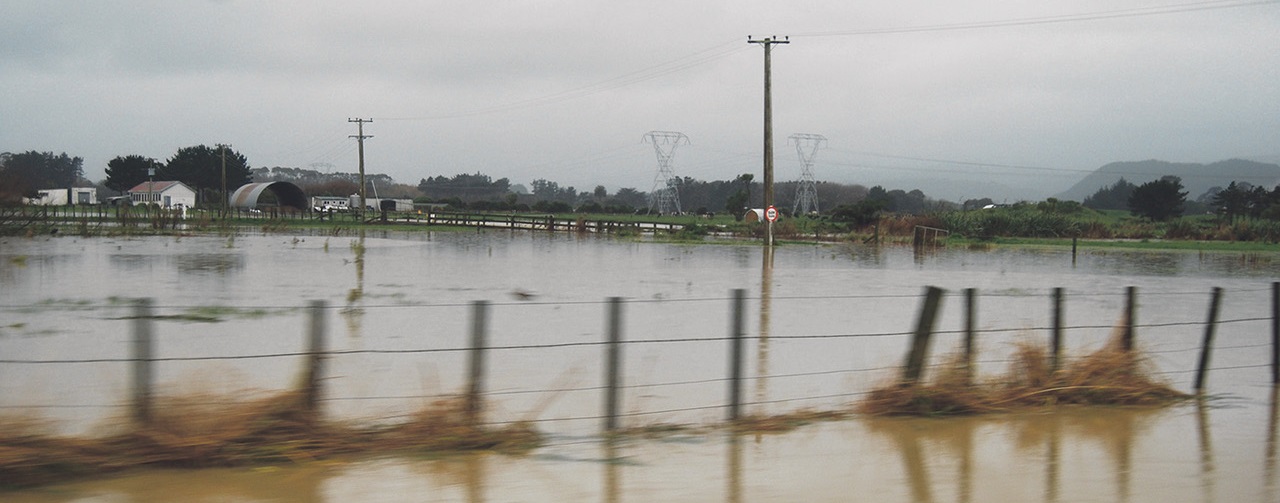
Ōtaki residents attending a community meeting on Saturday, July 1, got a stark reminder about the vulnerability of the district’s coastline.
While the Takutai Kāpiti Coastal Advisory Panel, which hosted the meeting, believed coastal enhancements and protection measures could hold the sea back in the short and medium term, long term (about 100 years), retreating was the best option. Modelling and technical reports showed there was significant risk of properties being inundated.

Flooding like this on Tasman Road is likely to be more common if nothing is done to mitigate sea-level rise.
Photo Ōtaki Today
The panel called the meeting to feed back to the community progress on work it has been doing in the Northern Adaptation Area, which includes the coastal areas of Ōtaki, Te Horo and Peka Peka, and a rural zone around those settlements. Once the process is completed, it will present the council with a range of recommendations. The recommendations will help the council develop its District Plan to manage coastal issues, and offer an approach to help the district deal with hazards in the future.
Panel members are former prime minister Jim Bolger (chair), former governor-general Sir Jerry Mateparae, Ōtaki’s John Barrett, Olivia Bird, Don Day, Dr Martin Manning, Melanie McCormick, Susie Mills and Moira Poutama.
The session, at Ōtaki Baptist Church, reported back initial recommendations for the Northern Adaptation Area, with each zone risking erosion and inundation.
Options available for managing erosion from rising sea levels included:
• Enhance – maintain and improve what is already being done for dune and wetland resilience, such as wind trap fencing, planting, managing dune access and wetlands, education and emergency management.
• Protect – keep the hazard away with beach nourishment (soft engineering).
• Retreat – move people,properties and infrastructure away from the hazard through land purchases, buyouts, land swaps, lease backs and future interests.
• Avoid – land-use planning. soft engineering (plantings and dune management) and hard engineering (such as sea walls) and the tough option – retreat.
For Ōtaki, Te Horo and Peka Peka beaches, the No 1 recommendation for erosion management was the same – enhance (short term and medium term), but retreat long term.
The panel noted that extensive foredune and backdune planting was needed in the short term, with weed and pest control to enhance the existing dune system, and to provide protection in storms and allow faster recovery.
This should be continued over the medium term, when efforts to enhance the dune system are increased. This approach is taken until it is no longer effective at managing the erosion risk.At this point, beachfront properties exposed to the erosion hazard would have to be relocated away from the hazard.
The pathways to deal with the inundation risk were slightly different from erosion, and broadly similar for each zone. They included:
• Enhance – as for erosion but including upgraded stopbanks and stormwater management.
• Protect – keep the hazard away with stopbanks, culverts and flood gates, and pump stations.
• Accommodate – live with the hazard by, for example, raising building floor levels.
• Retreat – as for erosion.
The preferred pathway for Ōtaki, Te Horo and Peka Peka beach areas was: enhance (short term), accommodate (medium term) and retreat (long term).
The panel noted that upgrades and maintenance of existing infrastructure would manage the short-medium term flood risk. This could include enhancing existing stopbanks and increasing drainage capacity of the existing stormwater outfalls. Coastal wetlands should be enhanced through effective planting and management.
Over the medium term, dwellings where the flood risk is not being effectively managed through the broader flood protection scheme would be proactively raised so floor levels were above projected water levels in large storms. Although dwellings would be protected, access to properties and services might still be affected.
As sea levels continue to rise, dwellings with inundation risks that are no longer effectively being managed through the broader flood protection scheme or raised floor levels would be retreated away from the hazard.
The panel said there were signals that could determine transition from one action to the next, and thresholds at which conditions would become unacceptable based on community values.
The triggers included warnings of change, such as raised groundwater levels, ponding, position of the shoreline, bund erosion, high renourishment costs, and retreat forced by insurance.
The thresholds included flood waters in dwellings, inability to get insurance, inability to get reliable access to a settlement, and inability to access reliable drinking water and wastewater.
Takutai Kāpiti is seeking feedback on its options, up to July 23. Look for “How will coastal hazards affect you?” at haveyoursay.kapiticoast.govt.nz More information about the panel and its work is at takutaikapiti.nz
OTHER STORIES
LATEST POSTS
- Kāpiti Aero Club flies into Te Horo spat
- Downtown PostShop, Kiwibank, Lotto in limbo
- Culinary icon Ruth Pretty moves on
- Councillor moots Blue Bluff swing bridge solution
- Local school lunches feed 1000 - Ōtaki Today
- Driver nabbed on expressway with kids at 175km-h
- Blazes worst I’ve seen – fire chief
- Cobblers Soup team looking for helpers
- Community gets behind Te Horo Hall fund
- Library recycling old domestic batteries recycling old domestic batteries
- Reservoir work progresses apace
- Murals brighten Te Horo Beach toilets
- Local SAR teams help in bush search
- New passion, new business for busy Bee
- Kite crazy
- Green waste beach dumping concerns
- Six-month bridge lane closure looms
- End of an era as Raukawa Dairy closes
- Community at heart of Mary-Jane’s ONZM
- Cops nail burnout hoons
- Racing club development goes for consent
- Pizza workers claim exploitation
- Memories revived as teen friends reunite
- All Saints gets a spruce-up
- Kāinga Ora reveals new homes
